Euphoria's Complicated Teenagers
Why the show's representation of young people matters

Growing up watching British TV doesn’t give you many options. When you’re at school, shows like Waterloo Road tell you that being a teenager is just a matter of being a bit stroppy. Once you’re in college, shows like the Inbetweeners imply there are essentially five categories: you can be nerdy, stupid, awkward, a liar or a girl. Then you might go to university, where shows like Fresh Meat limit your options to being a victim or a ‘legend’.
Skins provided brief respite. For a while, the show explored how young people can be interesting and multi-layered. But as Stewart Lee pointed out, the characters were a little too cool, and there was something quite cynical in the way their sassy, selfish lifestyles were so heavily marketed as aspirational.
Things are different across the pond. Euphoria, HBO’s drama about irreverent high-schoolers, understands that kids aren’t one dimensional and aren’t always cool. It’s honesty means the show never pulls any punches, and many reviewers found it excessive. “Euphoria’s unflinching depiction of heavy, gut-churning adolescent events adds up to an exhausting, exasperating experience,” moaned IndieWire’s Ben Travers.
Yet watching the show as a 21 year old made me wish I saw it as a teenager. Euphoria captures something essential about adolescence – the crazed expectations and the crushing realities – even if the stylish Californian parties couldn’t be further away from my suburban childhood in the Midlands.
This is partly to do with the details. From Juul e-cigarettes to glitter tears, the show is fluent in the language of Gen Z but doesn’t show off about it. Instead of Sherlock–style social media visuals cluttering the screen, simple subtitles are used when the characters are messaging. We end up spending more time looking at the character’s faces than looking at what’s on their screens – evidence of the show’s interest in the emotional realities that lie behind teenager’s virtual lives.

By establishing time and place through a consistent aesthetic and an eye for detail, the show could be compared to the likes of Stranger Things and This Is England. Yet those shows were evoking bygone teenage eras; what is so impressive about Euphoria is that it is capturing Gen Z while Gen Z are still young.
Perhaps the more interesting similarity with This Is England is how the show makes use of its young cast. Echoing Shane Meadows’ approach, Euphoria’s show runner Sam Levinson said “the idea was to create this energy with certain non-actors and actors that felt real and sort of honest”. This philosophy encouraged Levinson to give creative licence to his young ensemble, allowing them improvise some of the heavier scenes and contribute to the writing process.
This on-set collaboration between generations means the teenage characters in Euphoria end up feeling more nuanced than your bog-standard stereotypes. There are no Mean Girls or Rebels Without a Cause and, significantly, there are no characters to laugh at. Every character is shown in a setting where they thrive, be that Cassie’s ice-skating montage or Kat’s online side-hustle.

In fact, the characters are never a ‘type’. Rue, the show’s substance-abusing protagonist, is simultaneously smart, stupid, confident, anxious, self-aware and oblivious. She is not a jock, nerd, dupe or bully, but shockingly, a person. Similarly, Jules, Rue’s closest acquaintance, is unapologetically true to herself whilst also feeling the acute pressure of schoolyard gossip. As a stone-cold drug dealer trying to be a good friend to his customers, Fezco understands the hypocrisy of his actions yet knows his options are limited. The pumped up psycho-jock Nate Jacobs is as close as we get to a ‘villain’, but is clearly a product of an abusive relationship with his even more horrifying Dad.
Each storyline is complicated, ambiguous and, at times, incredibly bleak; some involve self-harm or extreme sexual violence. In fact, the candour in which the show confronts difficult topics caused some commentators to suggest the show is intended for an audience older than the teenagers themselves. Emily Todd VanDerWerff wrote that the “true audience for Euphoria is parents of kids who are about 5 to 10 years old, who still have relatively good relationships with those kids but can see the storm clouds on the horizon”.

But I disagree. The show is dark because being a 21st century teenager is dark. In the fog of financial instability, social media fretting and political impotence, there is little time for self-reflection. Seeing young people telling their own stories on screen can only help. Thank god then that TV teenagers are no longer simplistic clichés, but an incredibly rich source of drama, darkness and, sometimes, euphoria.
(A special 'bridge' episode of Euphoria" debuts on Sunday, December 6, before Season 2 drops in full in 2021)
About the Creator
Bob's picks
The world needs curating






Comments
There are no comments for this story
Be the first to respond and start the conversation.